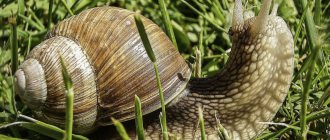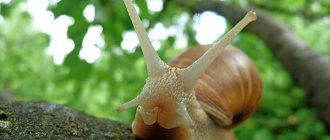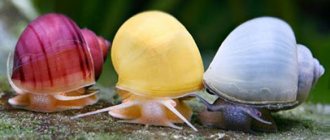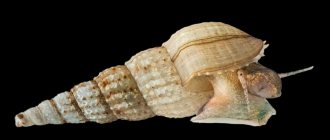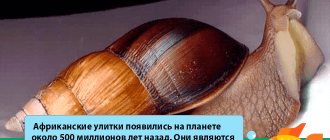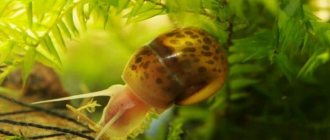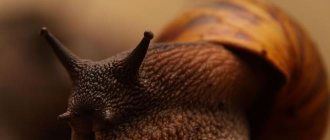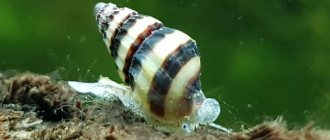Before you add a snail brought from the street into your home, you should weigh everything carefully and decide whether it is worth doing. Mollusks of the middle zone are more demanding in terms of living conditions than captive-bred Achatina or Archatina. In addition, no one can guarantee that a new pet will not be a carrier of infections or parasites. We will tell you what street snails are and how to keep them at home in this article.
Housing for your pet and proper care
A street snail can live in an ordinary aquarium, left over from a fish hobby that has not taken root. If you don't have an aquarium, you can use a terrarium or a large plastic container. Soil is poured onto the bottom; enough of it is needed so that the snail can burrow into it, since it serves as a bed for them. The substrate must be wet, but no water should come out when compressed.
Interesting! The soil in the terrarium plays an important role; during breeding, they make nests in it; the softer it is, the easier it is for them to make a place for laying eggs.
In addition, wild garden and forest snails are considered climbers; they often climb walls, and if they fall, the ground protects them from injury. But sawdust cannot be used, as they can eat it.
Read more about what to use as a terrarium and how to equip it for snails
When using store-bought coconut substrate for street snails, it is pre-soaked in water for several hours. When using land, it is taken from a park or forest. It is important that there are no fertilizers or chemicals in it. Before laying the house, it should be calcined at high temperatures or boiled. You can use ready-made soil for begonias from flower shops.
Instead of purchased soil, you can use sphagnum moss or peat, only neutralized. If the peat has high acidity, the forest snail shell will begin to deteriorate quickly.
Read about other types of soil for snails.
A lid is placed on the container. You can’t live without it, since the snail taken from the street is wild and very inquisitive, especially at home. She can run away and get lost. If it falls, it will break the sink or eat the wallpaper on the walls, which is also not allowed.
You can buy a terrarium, soil and other equipment for caring for forest and street snails on Aliexpress.
Additional recommendations
A healthy Achatina interacts with people with interest, has a clean, moist body and a strong, brightly colored shell. To ensure that it always remains like this, snail owners need to consider the following:
- The terrarium should be placed away from sunlight and drafts.
- You should not leave your pet outside the house unattended, as you may not be able to find it later.
- Shellfish love cucumbers very much, but they do not have much nutritional value.
- It is not recommended to feed snails peaches, as this causes their mucus to become too liquid.
- It is very important that Achatina does not come into contact with pesticides, household chemicals, and does not eat salt and sugar.
By following simple rules of care, you can raise a beautiful and cheerful pet. He will always feel the kind attitude of the owner and will definitely repay him in kind.
(Visited 191 times, 1 visits today)
What to feed wild animals at home?
In the first days of their lives, small street snails eat the shell of their eggs, which contains all the necessary substances. However, as adults, individuals change their gastronomic tastes. For example, grape snails love to eat young grape leaves, which is why they got their name. At home, the owner can feed the pet more varied.
Favorite foods also include leaves:
- Strawberries;
- Raspberries;
- Dandelion;
- Plantain.
Sometimes they can be found on horseradish, radish, cabbage and some other types of crops. Animals mainly feed on rotten parts, but it can also damage a healthy plant. Adult forest snails also feed on juicy fruits, so they readily eat fruits and berries, in particular strawberries in the spring.
Despite the fact that gastropods are considered herbivores, it has been noted that they can also eat food of animal origin - broken eggs, insect larvae, worms.
At home, forest and garden snails are omnivorous, but it is important that the food is fresh and juicy.
Forbidden! Dangerous products!
- Salt and chemical fertilizers;
- Bitter, sour, ready-made food for other domestic animals;
- Bread, pasta;
- Beans in any form and raw potatoes.
All other vegetables and fruits are allowed. Separately, you can cook chicken, boiled potatoes and eggs for wild garden snails, the main thing is not to add salt.
Most often, street pets are fed what they eat in the wild. But at home, protein and calcium are added to their diet.
Protein is found in specialized supplements such as daphnia and gammarus, and at home you can prepare simple and tasty snail food.
You should know it! It is not advisable to give snails pork or other meat; for them it is very tough and difficult to digest.
Wild snails need plenty of calcium. In nature, what street snails eat is already rich in calcium, but it should always be given at home. For this purpose, special sepia is used, from the store or feed chalk. You cannot use school chalk, it contains a lot of chemicals.
Important! It is strictly prohibited to use tablets from a pharmacy as calcium, as it is poison for them.
The mineral content is high in shell rock, chicken egg shells and fish bone meal. But all this must be ground in a coffee grinder in advance.
At home, wild street snails are fed once a day, preferably in the evening, as they sleep during the day. But over time, their rhythm may change.
Prohibited Products
It is strictly not recommended to consume certain types of food for domestic snails. This includes:
- products with a bitter or pungent taste: onions, garlic, chili peppers;
- vegetable products with a high content of natural acids: sorrel, citrus fruits, pineapple, cranberries;
- human food: sugar, salt, pasta, sweets;
- fatty dairy products (cheeses);
- fatty meat: pork, beef, lamb.
If you are unsure whether a particular type of food is suitable for home feeding your snails, do not feed it to avoid harming the animal's health.
Garden snails at home
Garden snails are not only sold in stores; in most parts of the country they can simply be brought from the garden. Grape snails may also be found among them. Caring for snails is easy; you should create conditions for them similar to wild ones.
Arrangement of a house for a garden snail
For pets to live, they need a terrarium with a size of about 19 liters and a wide bottom, as well as equipped with a lid with holes for ventilation. If the lid is missing, the mollusk can escape, since they easily climb along a vertical plane.
It is necessary to organize proper ventilation. There should be plenty of holes, since the street snail breathes oxygen and emits carbon dioxide.
The optimal temperature is room temperature, which must be maintained the same at all times.
Snails need soil at the bottom of the house; it is better to purchase ready-made soil in the store, it is absolutely safe and does not contain harmful bacteria. If this is not possible, then you can collect soil from the garden and process it at high temperatures for at least 30 minutes.
A natural substance can be laid on top of the soil; for this, sphagnum moss, peat or compost are used. Such a natural layer will maintain the required level of moisture in the soil.
For maximum activity, it is recommended to decorate the house. To do this, you can use artificial logs or tunnels from a pet store or real ones from the garden. Then the garden snail will be able to climb on them and hide if necessary.
Amazing decor for the terrarium can be purchased on the website.
Mollusks need moisture; for this, all objects and soil are regularly sprayed from a bottle. This procedure is carried out every two days.
It is advisable to spray the pets themselves, this will increase their health and beauty.
You need to feed the snail every day, but you should find out what forest and garden snails eat at home. They are unpretentious in nutrition. They enjoy eating fresh vegetables and fruits, herbs and cereals. Salting food is strictly prohibited. All products are finely chopped, making them easier for pets to eat.
Feeding rules
To get snails to eat, you need to make a program and stick to it. The basic rule here is: the smaller the animal, the less food is needed to feed it. Large mollusks need to be fed daily, small ones - 3 times a week.
The way they eat mollusks is very peculiar: they have sharp teeth with spikes on their tongues, with which they scrape off the top layer of food, like a grater.
Therefore, you should not give exclusively crushed food; you should leave pieces of different sizes.
Basic principles of nutrition:
- Animals are active at night, so they need to be fed in the evening.
- Do not place food on the base or bottom of the enclosure. It's better to use dishes.
- Any uneaten food debris must be removed quickly to avoid attracting harmful insects and preventing the development of fungi that can harm crustaceans.
- The snail's lair must have a container of clean water. To avoid drowning of land-based mollusks, the water level should not exceed 1 cm.
- Do not give your snails cold food (straight from the refrigerator). Food temperature should be room temperature or slightly warmer.
- To maintain shell elasticity, calcium must be added to the diet. It should be:
- crushed eggshells;
- mineral stone or sepia stone for birds;
- calcium-based pharmaceuticals;
- feed with plaster.
For snails, you can use a balanced fish food or pet turtle food. However, the basis of the diet should still be fresh fruits and vegetables.
Diversity of land snails
The most famous land mollusks include ordinary snails or, as they are also called, garden snails.
They differ from marine and pulmonary ones by the presence of a breathing hole. Basically, all snails of this type are herbivores, but some eat insects. You can have them as pets. Some species can live for 20 years.
Grape snail
The grape snail lives on average 8 years, but maybe longer. This shellfish is eaten and considered a delicacy. It stays awake from spring until the first autumn frosts. Then it goes into hibernation. An adult can reach 5 centimeters. Feeds on plants. You can meet snails in Central and Eastern Europe. The grape snail is easy to distinguish from other common street mollusks.
Today there are farms in the world where they are grown for food. And in nature you can find it in parks, on bushes, trees, vineyards, and in the grass.
Common Yantarka
Yantarka affected by the parasite
Common Yantarka has a transparent shell. It lives in many European countries and even North America. Snails are found in damp places and can sometimes submerge in water. They live only from 13 to 17 months.
Chains
Cepei is a genus of large snails. The height of snail shells reaches 16mm, and the width is 20mm. The length of the flail body reaches 40mm. Due to deforestation and the collection of snail shells by collectors, chains are included in the list of specially protected objects. The head and legs of some species may be translucent.
Austrian chain
The Austrian chain is a fairly common species. You can meet it in Russia, Hungary, Lithuania, Poland, Czech Republic, Bulgaria, Austria, Moldova and Ukraine. The chain has a cube-shaped shell with five whorls. Color - from white to yellow, with dark brown stripes. Eggs are laid at the end of July in moist soil. Lives on average 3 years.
Woody variant
The woody variantha has a spherical shell with smoothed curls. The shell color varies from yellow to brown.
A special feature of the species are small spots and streaks. The tree variant is found in Western and Central Europe, mainly in the mountains and relatively humid areas.
Shiny snail
The shiny snail is a steppe species; it chooses dry meadows, bushes, and forest edges for its habitat. Found in Slovakia, Hungary, Romania, Poland, Ukraine and Belarus. It has a spherical shell with four whorls, white or yellowish in color.
Bush snail
The bush snail has a round, large shell ranging in color from gray to red-brown and even blue-black. It can be found in Western Asia, as well as in Eastern and Central Europe. Prefers wet fields and meadows, or forest edges. It feeds on grass plants and goes into hibernation from October. It reproduces, like many mollusks, by laying eggs in the ground.
Faustina faustina
Faustina faustina is widespread in the Carpathians, but it can also be found on the plains; it is actively found in the Vinnytsia region. It chooses forested areas for its habitat. It is considered one of the most beautiful snails due to its shiny conical shell.
Cepaea sylvatica
Cepaea sylvatica is one of the rarest species of chains. Can be found in Northern and Central Europe. In Russia, this chain can be found in the Leningrad and Kaliningrad regions. Prefers well-warmed areas. It feeds on lichen, detritus and some types of fungi. It reproduces by laying eggs in the ground.
Gibbula divaricata
Gibbula divaricata lives off the coast of the Black, Adriatic and Mediterranean seas. In the Black Sea, gibbula can be found along the entire coast. The mollusk is easy to identify by its cone-shaped shell with seven or six whorls. Feeds on detritus and algae.
The mollusk reproduces in the summer, throwing eggs into the sea.
Bielzia coerulans
A very unusual and rare representative of the mollusks Bielzia coerulans, also called Limacida. It has an amazingly beautiful color (purple, blue or green). You can meet it in Ukraine, the Czech Republic, Poland, Slovakia and Romania, in coniferous and mixed forests. It belongs to the pulmonary group and does not have a shell. The body length of bielsia is from 10 to 14 centimeters. It is a hermaphrodite, and after laying eggs the snail dies.
How do snails eat and do they have teeth?
In general, there are land snails and freshwater snails; in terms of nutrition, the difference is that some are herbivores, others are predators. Land animals live at home in special containers, while freshwater animals live in aquariums. A striking representative of land animals are Achatina.
Did you know? Snails appeared more than 600 million years ago, making them one of the oldest organisms on the planet.
Their mouth extends into a tube containing rows of sharp teeth. They are presented in the form of a kind of grater, with the help of which the mollusk scrapes off food. This is necessary because most of their food comes from plants (for example, they nibble on the top layer of a tree trunk). In general, the number of teeth reaches 25,000 or more. Both species have the same mouth structure and a chitinous band, but the arrangement of the teeth on it differs depending on the species.
Find out how to keep and how to care for the snail Ampularia, Helena, Coil, Prudovik, Luzhanka and Achatina.
Also, predators secrete a special liquid before consuming it, which softens the food. The teeth are movable, allowing them to grind food. Because of this, they are gradually erased and then renewed. On average, a mollusk can grow 5 new rows of teeth per day. The main principle of nutrition is similar to the operation of an escalator bucket - food is obtained by collecting, after which it is ground with the tongue and sent into the esophagus.
Decoration of the terrarium
Keeping Achatina involves purchasing an aquarium or terrarium, the height of the walls of which must be at least 50 cm. The terrarium must be closed so that the mollusk cannot get out. However, it is necessary to make holes in the lid into which air will flow.
We invite you to read why cats do not eat or drink water after sterilization: what to do
Care and maintenance of Achatina is very simple
It is important to ensure the necessary air humidity and temperature in the terrarium. The temperature in the terrarium should range between 25–28 °C
A slight decrease in temperature is not so critical for the mollusk; at such moments it simply becomes less mobile. Air humidity is controlled using an ordinary spray bottle, which is used to spray the walls.
Care and maintenance of Achatina must begin with the design of the terrarium. There must be a layer of soil in it. Soil for Achatina snails can be bought in a specialized store, or you can prepare it yourself. It is prepared from a mixture of peat, sand and humus. It is poured in a layer of 5–7 cm. It must be loose and maintain good air humidity.
The soil is replaced once a year. But this does not mean that you only need to remove snails once a year. Cleaning up excrement and waste food should be done regularly.
Principles of organizing proper nutrition for African Achatina
There are basic principles of snail nutrition that apply to all species:
- Achatina’s daily diet should include a variety of plants;
- Important animal proteins supplement the snails' main diet;
- The third mandatory component of the diet of Achatina snails is mineral feeding.
The nutrition of African Achatina snails at home is based on these three basic principles. A constant lack of one of the components will lead to illness in the tender snail and its possible death.
The African snail Achatina in its natural habitat prefers leaves and grass, tree bark and juicy tropical fruits. It seems that Achatina are real gourmets, they can eat fresh herbs and immediately snack on half-rotten berries. Certain species of Achatina consider fallen rotting wood a real delicacy and can eat it entirely in a huge colony without leaving a trace. As you know, snails have many teeth, they are quite voracious, often attack large plantations of cultivated plants and in a short time cause irreparable damage to farming.
Under no circumstances should cut up newspapers be placed in the aquarium of domestic snails as bedding. Eating paper, especially with printed font, will lead to the death of pets. And, most importantly, the tender Achatina is very afraid of grains of salt. They corrode their thin skin and burn their insides. Half a teaspoon of salt can kill an entire herd of defenseless snails!
It is not advisable to include citrus fruits and other sour fruits in the daily diet of Achatina snails. Any strong acids negatively affect the digestion and vital functions of Achatina. These foods are not strictly prohibited; they can be given in limited quantities and the reaction and condition of the snails can be monitored.
How often and in what quantity to feed
In order for the life of a mollusk in an aquarium to be comfortable, it is necessary to adhere to certain rules. One important aspect is the volume of the tank in which they live. To increase the likelihood of growing a large snail, about 12–15 liters per individual is required.
Achatina eat lettuce leaves
Another important rule is nutrition. We'll talk about how to feed snails at home.
Food must be given in the evening, since domestic snails are nocturnal animals. It is recommended to feed shellfish once a day. The amount of food depends on the number of individuals. There is no need to worry about overeating snails, as they always know their limits. The tastes of each individual are different. You can notice this by observing the process of the meal. Almost every snail eats one type of food.
You need to be careful when feeding baby snails. Their diet is noticeably different from the diet of adult mollusks. Kids eat mostly greens and grated carrots. Over time, you can switch to apple pieces.
Permitted cultivated herbs (greens)
These include greens, which we ourselves often add to salads or eat just like that, as well as tops:
- leaf lettuce - frillis, oakleaf, the most common - any cultivated leaf lettuce
- dill
- parsley
- carrot and beet tops
- microgreen sprouts - for example, pea greens or mung beans
- asparagus
- spinach
If you buy microgreens for a snail, look at what herbs it is grown from. If it is mustard greens, you should not give it. Try it yourself - if the grass is bitter or has a mustard taste, you should not give it to the snail.
Dill
In addition to the above, you can include leaves of fruit trees and berries in your diet:
- raspberries
- cherries
- apple trees
- strawberries and wild strawberries
In limited quantities you can:
- celery
- cilantro
- basil
- fenugreek herb
According to my observations, my pet is indifferent to such herbs, which is why I don’t collect them. And in general, the leaves of trees are mostly dry, which is why snails don’t like them.
Iceberg lettuce
The TOP 3 of cultivated herbs are:
- Lettuce - any options
- Microgreens
- Beet and carrot tops
She is more indifferent to other herbs and only eats when hunting.
What should you not give them?
There are products that are contraindicated for feeding snails; they cannot be found in the natural environment, and they can be extremely dangerous for mollusks:
- Any pickled, smoked and salted foods;
- Sweet and butter products;
- Pasta is too hard for them;
- Raw potatoes (only boiled ones will do);
- Anything that contains food additives and spices;
- Ready-made food for cats and dogs;
- Pork and lamb are too fatty.
Toddlers need calcium to strengthen their shells, but don't use school chalk or drugstore tablets. Uncooked eggshells, finely ground, cottage cheese and meat and bone meal work well.
Maintain animal hygiene, otherwise they will get sick. To do this, periodically give them a shower with a spray bottle, clean the house of mucus and change the soil. But you should not wash the snail under running tap water, it is too hard and contains chlorine. In addition, you may not be able to hold the baby and it will swim away.
How to cook food for Achatina?
- Food should not be given to Achatina immediately from the refrigerator; it must only be at room temperature. If you decide to feed the snails soft vegetables or fruits, then they should be finely chopped.
- With solid products you will have to tinker. They need to be finely grated or pureed. It is better not to put soft products in a cage with small Achatina, as they can suffocate if they get inside.
- Newborn Achatina should immediately receive finely chopped greens and thinly sliced carrots, and after a few days they can be “pampered” with lettuce leaves and an apple.
- Sometimes it happens that Achatina ignores some varieties of apples or pears, while others eat with appetite. In this case, try different types of them, and give them those that the snails choose for themselves. And another very important point: immediately accustom the mollusks to the food that you can feed them all year round.
